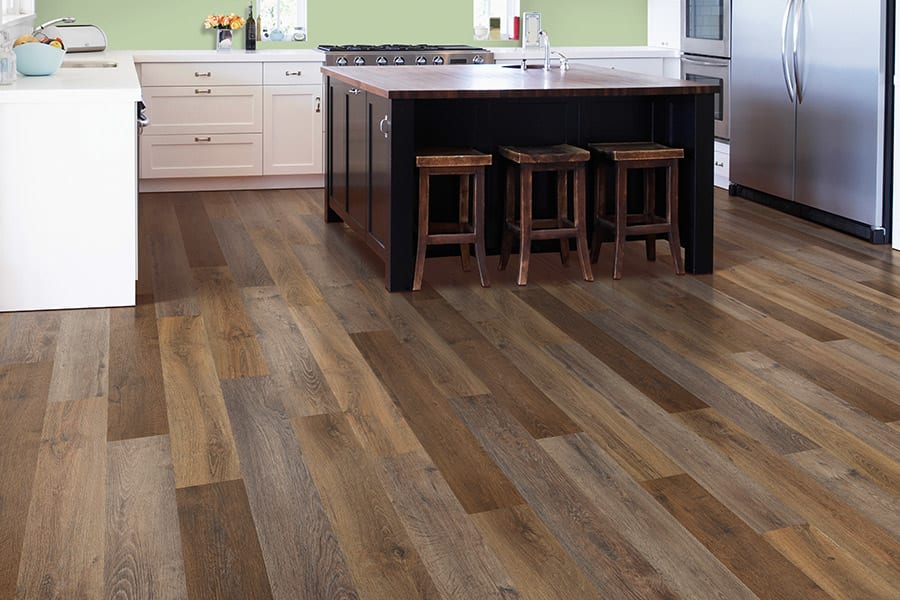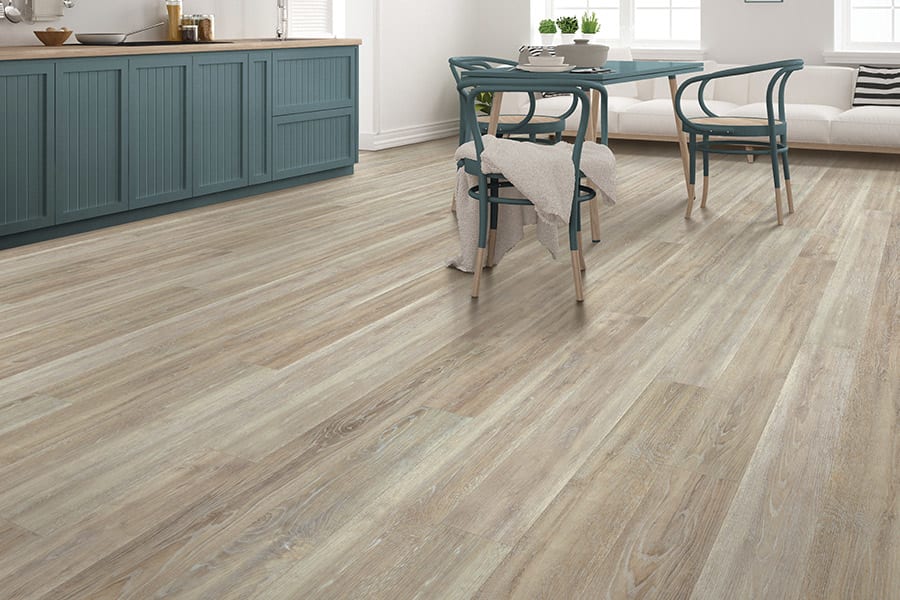LVF, LVP, and LVT: What do they all mean?
They are all part of the same flooring type. Luxury vinyl flooring is often just referred to as LVF. As part of the many design options, this flooring can be cut into square, groutable, tile-sized pieces (LVT Flooring) or planks.
What is LVF?
This vinyl is a remarkably realistic mimic of wood, tile, or stone. It is completely waterproof, so that makes it ideal for kitchens, baths, and other wet spaces, but it's so stylish we're seeing it installed in every room in the house. We're also seeing it installed in high-end homes where once only genuine wood or stone would be considered.
The images are taken with 3D photography so they're clear and accurate. You will see knots, grains, swirls, wormholes, and veining variations. The colors and patterns are vibrant.
Embossing adds depth and dimension. Textured appearances are also available: wire-brushed, hand scraped, weathered, and distressed. Matte, gloss, and high gloss finishes are also available.
All colors, patterns, species, and designs follow current trends. Some of the trends you can follow are whitewashed and light gray floors for the farmhouse-style kitchen; wood floors anywhere; marble bathrooms and textures. You can even combine two trends, such as the metal combined with stone for a copper-colored slate floor.
The images are taken with 3D photography so they're clear and accurate. You will see knots, grains, swirls, wormholes, and veining variations. The colors and patterns are vibrant.
Embossing adds depth and dimension. Textured appearances are also available: wire-brushed, hand scraped, weathered, and distressed. Matte, gloss, and high gloss finishes are also available.
All colors, patterns, species, and designs follow current trends. Some of the trends you can follow are whitewashed and light gray floors for the farmhouse-style kitchen; wood floors anywhere; marble bathrooms and textures. You can even combine two trends, such as the metal combined with stone for a copper-colored slate floor.
Request an estimate
What’s this about cuts?
Vinyl plank flooring (LVP) is made from strips mounted on boards and generally associated with hardwood. Some prefer them for stone looks because they feel the size gives it more of a look of quarried marble. As for LVT flooring, some take the realism a step further by using grout which is now available in many colors, making it an important design tool.
This vinyl is thicker than standard. LVF is layered and at the top is a clear melamine wear layer that protects the floor from scratches and scuffs. It also keeps spills at the surface, just waiting to be wiped off.
All LVF is easy to care for. All it needs is a regular, daily if possible, sweeping. Clean with a damp mop and manufacturer-approved cleaner.
Installation is a fairly uncomplicated floating floor where the pieces first click together then hover over the subfloor. No staples, nails, or glue are needed. Subfloors, however, must be clean, dry, and even.
To find out more about LVT and LVP visit the Henry's Floor Covering showroom in Greencastle, PA. We service Greencastle, Chambersburg, Waynesboro, Mercersburg, PA as well as Hagerstown, MD. Ask about our free quotes.
This vinyl is thicker than standard. LVF is layered and at the top is a clear melamine wear layer that protects the floor from scratches and scuffs. It also keeps spills at the surface, just waiting to be wiped off.
All LVF is easy to care for. All it needs is a regular, daily if possible, sweeping. Clean with a damp mop and manufacturer-approved cleaner.
Installation is a fairly uncomplicated floating floor where the pieces first click together then hover over the subfloor. No staples, nails, or glue are needed. Subfloors, however, must be clean, dry, and even.
To find out more about LVT and LVP visit the Henry's Floor Covering showroom in Greencastle, PA. We service Greencastle, Chambersburg, Waynesboro, Mercersburg, PA as well as Hagerstown, MD. Ask about our free quotes.












